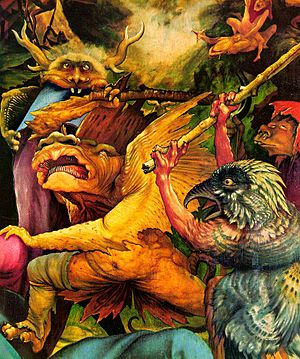Hallucination facts for kids

A hallucination happens when you see, hear, taste, smell, or feel things that are not really there. It's like your brain is playing a trick on your senses! People usually have hallucinations when they are awake and aware of their surroundings.
Hallucinations are different from dreams. Dreams happen when you are asleep. They are also different from illusions. An illusion is when something real looks or sounds different from what it actually is. For example, seeing a mirage on a hot road is an illusion, not a hallucination.
Sometimes, a lack of sleep can cause hallucinations. It's also quite normal to have a brief hallucination just as you are falling asleep or right after you wake up. These are often called hypnagogic or hypnopompic hallucinations.
Contents
What Causes Hallucinations?
Hallucinations can happen for many different reasons. They don't always mean a person is seriously ill.
Common Causes
- Lack of sleep: Not getting enough sleep can make your brain tired and cause it to create things that aren't there.
- High fever: When someone has a very high fever, especially from a virus like the common cold, they might see or hear things.
- Certain illnesses: Some medical conditions, like certain types of epilepsy, can lead to hallucinations.
- Brain changes: Sometimes, changes in the brain can cause a person to have hallucinations.
- Some medicines: Certain medications can have side effects that include hallucinations.
Types of Hallucinations
Hallucinations can affect any of your five senses.
Seeing Things (Visual Hallucinations)
This is when a person sees objects, people, or patterns that are not actually there. For example, someone might see a person sitting in a chair when no one is there.
Hearing Things (Auditory Hallucinations)
This type of hallucination involves hearing sounds or voices that no one else can hear. People might hear music, whispers, or even full conversations.
Smelling Things (Olfactory Hallucinations)
An olfactory hallucination means smelling odors that are not present. This could be a pleasant smell, like flowers, or an unpleasant one, like smoke.
Tasting Things (Gustatory Hallucinations)
This is when a person tastes something that isn't there, or tastes something different from what they are eating. For example, food might taste metallic or bitter for no reason.
Feeling Things (Tactile Hallucinations)
Tactile hallucinations involve feeling sensations on the skin or inside the body that are not real. This could be feeling insects crawling on the skin or a strange tingling sensation.
How Many People Experience Hallucinations?
Hallucinations are more common than you might think! Studies have been done around the world to understand how many people have these experiences.
One study from 1894 suggested that about 10% of people experience hallucinations. More recently, a large survey of over 13,000 people found an even higher number. This study reported that almost 39% of people had experienced a hallucination at some point.
About 27% of people in that survey reported having hallucinations during the daytime. Most of these experiences happened when they were not sick or taking any substances. The survey also found that hallucinations affecting smell or taste seemed to be the most common types for people in general.
See also
 In Spanish: Alucinación para niños
In Spanish: Alucinación para niños

